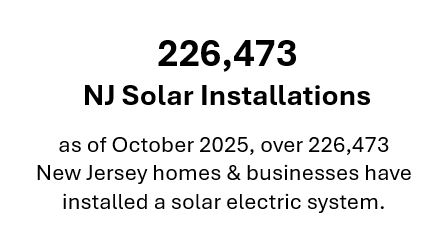Administratively Determined Incentive (ADI) Program
ADI Program Online Registration Portal
Registrants must submit an ADI Initial Registration packet with all required documents through the ADI online registration portal.
The ADI Program Registration Portal is open to new registrations.
Announcements
All solar installers, developers and administrative staff are invited to participate in this virtual Solar Installer Training.
Please register for the webinar, here and the agenda can be found, here.
At the conclusion of the webinar, the Recording and Q&A will be located below under the ADI Program Solar Installer Training heading.
After registering, you will receive a confirmation email containing information about joining the webinar and checking your system requirements. We encourage all registrants to follow these instructions and check their systems ahead of the meeting to ensure that they will have access.
![]()
Please take notice that, substantially in response to recent federal changes limiting the availability of the federal solar Investment Tax Credit (ITC) and setting certain deadlines regarding the ITC, the New Jersey Board of Public Utilities (Board), by Order dated August 13, 2025, has, waived the prohibition against commencing construction prior to receipt of the ADI Program notice of conditional registration enumerated in N.J.A.C. 14:8-11.4(b) for net-metered residential and net-metered non-residential projects that submit a complete ADI initial registration package through the ADI online registration portal in accordance with the following timelines:
- Submit the complete package on or after July 4, 2025
- Submit the complete package on or before December 31, 2025
- NOTE: Staff is authorized to extend the deadline to July 4, 2026, if it is deemed necessary, but only for net metered non-residential projects.
The Program Manager will automatically apply the waiver to all initial registrations meeting the stated criteria. ) The subject waiver does not apply to solar facilities registering in the Community Solar Energy program (CSEP), Competitive Solicitation Incentive (CSI) Program and Remote Net Metering market segment. For more information, see I/M/O in the Matter of A Successor Solar Incentive Program Pursuant to P.L. 2021, c.169, BPU Docket No. QO20020184 (August 13, 2025), available here.
Board Orders
2025
Per Board Order dated May 21, 2025 (effective date May 28, 2025) IN THE MATTER OF A SUCCESSOR SOLAR INCENTIVE PROGRAM PURSUANT TO P.L. 2021, C.169, IN THE MATTER OF CERTIFICATION OF ENERGY YEAR 2024 COST CAP CALCULATION AND SETTING ADI PROGRAM MEGAWATT BLOCKS FOR ENERGY YEAR 2026.
Per Board Order, dated March 19, 2025 (effective date 3/26/2025), In the Matter of a Successor Solar Incentive Program Pursuant to P.L. 2021, C., 169; Order Reallocating Capacity in the ADI Program, the Board has approved 75 MW of solar capacity from the ADI non-residential capacity block to be reallocated to the ADI residential capacity block.
![]()
Archive Directory
The following archive directory include all board orders prior to 2025:
ADI Program Solar Installer Trainings:
| Date of Training | Presentation | Webinar Recording | Q&A |
| Sept 11, 2025 | Presentation |
Recording | Coming Soon |
| Dec 6, 2024 | Presentation | Recording | - |
| May 2, 2024 | Presentation | Recording | - |
| Dec 13, 2023 | Presentation | Recording | - |
| Feb 24, 2023 | Presentation | Recording | Q&A |
Energy Year 2026 ADI Capacity Blocks by Market Segments
| Market Segments | System Size | Capacity Blocks MW (dc) |
| Net-Metered Residential (1) | All Sizes | 250 MW |
| Net Metered Non-Residential (2) | All sizes at or below 5 MW |
150 MW |
| Remote Net Metering (RNM) | All sizes at or below 5 MW | 50 MW |
| Community Solar (3) | All sizes at or below 5 MW | Unused EY 2025 Capacity |
Note: Current available capacity for each market segment will be posted on the homepage of the ADI online portal.
Per Board Order dated May 21, 2025 cost cap calculation and setting ADI Program megawatt clocks for Energy Year 2026 (June 1, 2025 - May 31, 2026)
![]()
- The ADI Program will accept new registrations for each market segment on a first-come, first-served basis until the MW block for that market segment is fully subscribed.
- A MW block would be defined as being fully subscribed when the last registration received in the ADI registration portal causes the total capacity of all registrations in that block to exceed the capacity allocation for said block (the last project allowed to register in a given MW block could lead to the slight exceedance of said MW block).
- When the MW block for a given market segment is fully subscribed as defined above, the ADI Program registration manager will close the registration portal for that market segment and stop accepting new registrations in that market segment until the next capacity block is opened.
- There will not be a waiting list for projects seeking to enter a capacity block for a particular market segment that is already fully subscribed.
ADI Incentives (SREC-IIs) per Market Segment
| Market Segments | System Size MW (dc) | SREC-II Value | *Public Entities ($20 Adder) |
| Net-Metered Residential | All Sizes | $85 | N/A |
| Small Net-Metered Non-Residential located on Rooftop, Carport, Canopy and Floating Solar | Projects smaller than 1 MW | $110 | $130 |
| Small Net Metered Non-Residential Ground Mount | Projects smaller than 1 MW | $90 | $110 |
| Large Net Metered Non- Residential located on Rooftop, Carport, Canopy and Floating Solar | Projects 1 MW to 5 MW | $100 | $120 |
| Large Net Metered Non-Residential Ground Mount | Projects 1 MW to 5 MW | $85 | $105 |
| Remote Net Metering | Up to 5MW | $90 | N/A |
| Community Solar | Up to 5 MW | $80 | N/A |
*“Public Entity” is defined as a customer that is a State entity, school district, county, county agency, county authority, municipality, municipal agency, municipal authority, New Jersey public college, or New Jersey public university
- An ADI-eligible facility that, in its entirety, could be eligible for two or more market segments shall be assigned to the market segment with the lower incentive value
ADI Program Key Eligibility Requirements:
- Net-metered residential, non-residential solar facilities 5 MW (dc) or less, and community solar projects.
- Solar facilities that have not yet reached commercial operation (defined as permission to operate) prior to the opening of the ADI Program.
- Solar facilities that reached commercial operation before August 28, 2021, must be granted special dispensation by NJBPU to participate in the ADI Program.
- All solar equipment must be new.
- Solar facilities connected to a distribution or transmission system owned or operated by a New Jersey public utility or local government unit.
- Solar facilities receiving incentives that are 1 MW (dc) or greater in size are subject to the Prevailing Wage Act N.J.S.A. 34:11-56.25, et seq.
ADI solar facilities are prohibited in the ADI Program from “Commencing Construction” (defined as obtaining permission to operate or PTO), prior to receipt of acceptance into the ADI program. Solar facilities that obtain PTO prior to the issuance of the ADI acceptance letter will be required to petition the Board for eligibility in the ADI Program.
Clarifying ADI Eligibility Requirements:
- Clarifying ADI Eligibility Requirements Memo January 2023
ADI Registration Packet Materials
The ADI Initial Registration packet must include all the documents listed on the ADI Initial Application Checklist(s) below:
ADI Initial Registration Checklists and Forms:
- ADI Initial Registration Checklist for Behind the Meter Projects (PDF)
- Company Digital Signature Authorization Form (PDF)
- ADI Registration Certification Form (PDF)
- Certification Form for Customer of Unresponsive Solar Installer (PDF) April 2025
- ADI Disclosure Form for Purchase (EXCEL)
- ADI Disclosure Form for Purchase (PDF)
- ADI Disclosure Form for Lease (EXCEL)
- ADI Disclosure Form for Lease (PDF)
- ADI Disclosure Form for PPA (EXCEL)
- ADI Disclosure Form for PPA (PDF)
- Solar Incentive Affidavit for Co-Located Solar Facilities
Milestone Reporting Forms
The Milestone Reporting Form is required for net metered and community solar facilities greater than 1 MW (dc) and all grid supply projects. This form must be submitted with the initial application packet and quarterly thereafter, up until the submission of the Final As-Built (Post Construction Certification) Package.
- Milestone Reporting Form-Net Metered Projects 1 MW (dc) to 5 MW (dc) (EXCEL)
- Milestone Reporting Form-Interim Subsection (t) Grid (EXCEL) August 2022
![]()
The Final As-Built (Post Construction Certification) Packet
- ADI Final As-Built Checklist
- ADI Final As-Built Solar Technical Worksheet
- ADI Final As-Built Solar Technical Worksheet - PDF
- Post Construction NJCEP Compliance Form Solar Act Subsection (t) N.J.S.A. 48:3-87
![]()
Identifying Minor and Major Deficiencies for Incomplete ADI Registration Packets
As the ADI Registration is reviewed, it will either be accepted or deemed incomplete. This document explains how the ADI Program Team identifies minor and major deficiencies within your registration packet.
Tools needed to complete the Final As- Built Forms and Equipment Information
NJCEP reserves the right to request a complete copy of production estimates, a full shade analysis, or any relevant documentation from the installer at any time. Save a copy of the “Results” pages for permanent record with the project file.
PV Watts/System Advisor Model (SAM)
Commonly Used Shading Analysis Tools
NJCEP permits the use of other tools as long as the tool can provide a full summary report, in case the ADI Program Manager requests copies.
To Verify the Solar Azimuth Orientation
- Solmetric Roof Azimuth Measurement Tool
- NOAA's National Centers for Environmental Information (NCEI) (formerly the National Geophysical Data Center)
Instructions on ADI Requirements for Decreases and Increases to the Solar System
Per Board Order below, dated April 26, 2023, the 10% or 25 kW limit for increasing the size of the solar facility referenced in your initial ADI registration packet has been increased to 20% or 25 kW, whichever is less. Solar facilities that submit their post construction packet prior to May 3, 2023, (effective date of the Board Order) and move their ADI registration status to Final As-Built Received, will be subject to the 10% or 25% increase requirements.
The ADI Program allows solar systems to be increased in size by up to 10% or 25 kW (dc), whichever is smaller, from the original system size proposed in the initial ADI Registration Packet. Solar facilities cannot increase their system more than 10% or 25kW (dc) and cannot increase the system capacity by any amount that would expand the project beyond 5 MW (dc). Solar facilities can decrease in size from the initial registration submitted with no restrictions.
- Board Order: Waiving ADI Projects May 2023
Understanding Co-Location as Defined in the Proposed Rules
Co-location is not permitted in the ADI Program, unless the Board grants a waiver in response to a petition.” N.J.A.C. 14:8-11.4(f). Co-location is defined as “siting two or more SuSI-eligible solar facilities on the same property or on contiguous properties, such that the individual facilities are eligible for a higher incentive value than they would be if they were combined into one single facility.” An exception is made for certain net metering projects: “In the case of net metered projects, SuSI-Eligible solar facilities shall not be deemed co-located if they serve separate net metering customers as defined at N.J.A.C. 14:8-4.” N.J.A.C. 14:8-11.2. A single customer with facilities connected to multiple utility accounts on one property would be considered co-located. An ADI-eligible facility that, in its entirety, could be eligible for two or more market segments shall be assigned to the market segment with the lower incentive value.
- An entity may file a petition with the Board for special dispensation to engage in co-location of facilities.
- Co-located projects are allowed if the project's registrant voluntarily agrees to accept the lowest incentive that would apply if the projects combined into a single project located on the site.
- Developers or owners cannot site multiple projects on the same property or contiguous properties in order to access a higher incentive level assigned to a smaller project (example: two 1 MW dc projects would receive a higher incentive than one project just under 2 MW dc.)
- Co-location is prohibited if the combined capacity of systems on a single site or contiguous site exceeds 5 MW dc.
- If the review of the Post Construction Certification (Final As-Built) Packet or project inspection reveal that the registrant failed to disclose co-located solar facilities, the Board may take enforcement action, including but not limited to adjusting the incentive downward by multiplying the aggregated project size by the lowest incentive level among the projects’ qualifying market segments.
Extension Policy
ADI solar facilities accepted in the ADI Program may be eligible for one 6-month extension. The registrant may apply for an extension for any solar installation that cannot complete the installation and submit a complete Final As-Built (Post Construction Certification) Packet with permission to operate from the Electric Distribution Company in the ADI online registration portal by the expiration date noted in the ADI Acceptance Letter.
Extension Requests will be reviewed and considered on a case-by-case basis and should include supporting documentation of extenuating circumstances for the delay in completing the facility, evidence that the facility has made progress towards completion, and demonstrations of the likelihood of timely and successful completion of the solar facility. For facilities 1 MW (dc) or greater, the ADI Program Team will consider whether the registrant has submitted timely quarterly milestone reporting forms. If the extension is granted, the ADI Program will provide a new registration expiration date six months from the expiration on the original conditional ADI Acceptance Letter.
Any ADI solar facility that would like to submit a request for a second extension must submit a petition to the NJBPU, for consideration.
Understanding Solar Ownership and Financing Options
Learn more about solar ownership and financing options.
Program Contacts
Correspondence and inquiries should be directed to:
New Jersey's Clean Energy Program
Successor Solar incentive (SuSI) Program
Administratively Determined Incentive (ADI) Program
NJREINFO@NJCleanEnergy.com
Phone: 866-NJSMART (866-657-6278)









.jpg)


